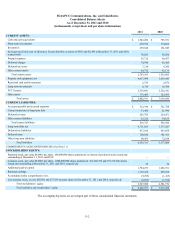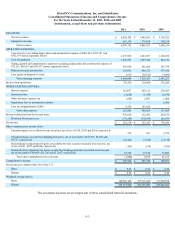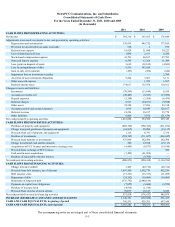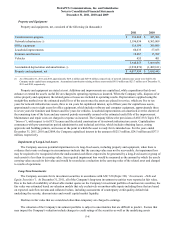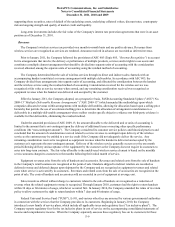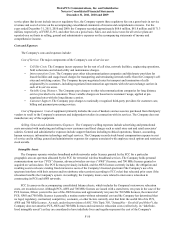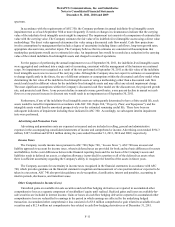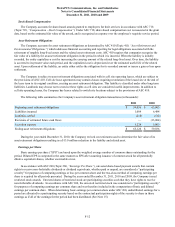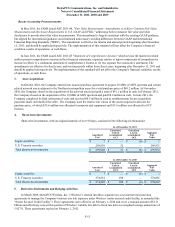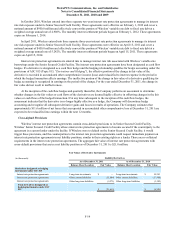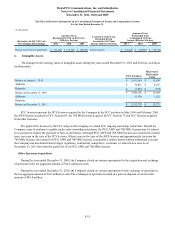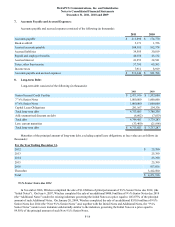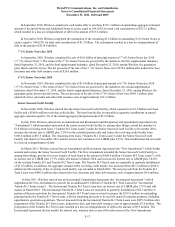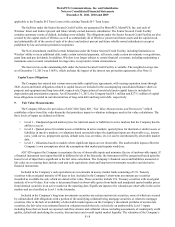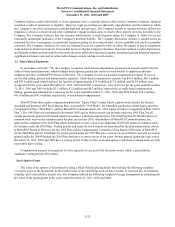Metro PCS 2011 Annual Report Download - page 118
Download and view the complete annual report
Please find page 118 of the 2011 Metro PCS annual report below. You can navigate through the pages in the report by either clicking on the pages listed below, or by using the keyword search tool below to find specific information within the annual report.
MetroPCS Communications, Inc. and Subsidiaries
Notes to Consolidated Financial Statements
December 31, 2011, 2010 and 2009
F-12
Stock-Based Compensation
The Company accounts for share-based awards granted to employees for their services in accordance with ASC 718
(Topic 718, “Compensation - Stock Compensation”). Under ASC 718, share-based compensation cost is measured at the grant
date, based on the estimated fair value of the award, and is recognized as expense over the employee's requisite service period.
Asset Retirement Obligations
The Company accounts for asset retirement obligations as determined by ASC 410 (Topic 410, “Asset Retirement and
Environmental Obligations”) which addresses financial accounting and reporting for legal obligations associated with the
retirement of tangible long-lived assets and the related asset retirement costs. ASC 410 requires that companies recognize the
fair value of a liability for an asset retirement obligation in the period in which it is incurred. When the liability is initially
recorded, the entity capitalizes a cost by increasing the carrying amount of the related long-lived asset. Over time, the liability
is accreted to its present value each period, and the capitalized cost is depreciated over the estimated useful life of the related
asset. Upon settlement of the liability, an entity either settles the obligation for its recorded amount or incurs a gain or loss upon
settlement.
The Company is subject to asset retirement obligations associated with its cell site operating leases, which are subject to
the provisions of ASC 410. Cell site lease agreements may contain clauses requiring restoration of the leased site at the end of
the lease term to its original condition, creating an asset retirement obligation. This liability is classified under other long-term
liabilities. Landlords may choose not to exercise these rights as cell sites are considered useful improvements. In addition to
cell site operating leases, the Company has leases related to switch site locations subject to the provisions of ASC 410.
The following table summarizes the Company's asset retirement obligation transactions (in thousands):
2011 2010
Beginning asset retirement obligations $ 59,036 $ 63,005
Liabilities incurred 1,084 6,484
Liabilities settled (218)(512)
Revisions of estimated future cash flows — (13,004)
Accretion expense 5,224 3,063
Ending asset retirement obligations $ 65,126 $ 59,036
During the year ended December 31, 2010, the Company revised cost estimates used to determine the fair value of its
asset retirement obligations resulting in a $13.0 million reduction in the liability and related asset.
Earnings per Share
Basic earnings per share (“EPS”) are based upon the weighted average number of common shares outstanding for the
period. Diluted EPS is computed in the same manner as EPS after assuming issuance of common stock for all potentially
dilutive equivalent shares, whether exercisable or not.
In accordance with ASC 260 (Topic 260, “Earnings Per Share”), unvested share-based payment awards that contain
rights to receive non-forfeitable dividends or dividend equivalents, whether paid or unpaid, are considered a “participating
security” for purposes of computing earnings or loss per common share and the two-class method of computing earnings per
share is required for all periods presented. During the years ended December 31, 2011, 2010 and 2009, the Company issued
restricted stock awards. Unvested shares of restricted stock are participating securities such that they have rights to receive
non-forfeitable dividends. In accordance with ASC 260, the unvested restricted stock was considered a “participating security”
for purposes of computing earnings per common share and was therefore included in the computation of basic and diluted
earnings per common share. When determining basic earnings per common share under ASC 260, undistributed earnings for a
period are allocated to a participating security based on the contractual participation rights of the security to share in those
earnings as if all of the earnings for the period had been distributed (See Note 15).


